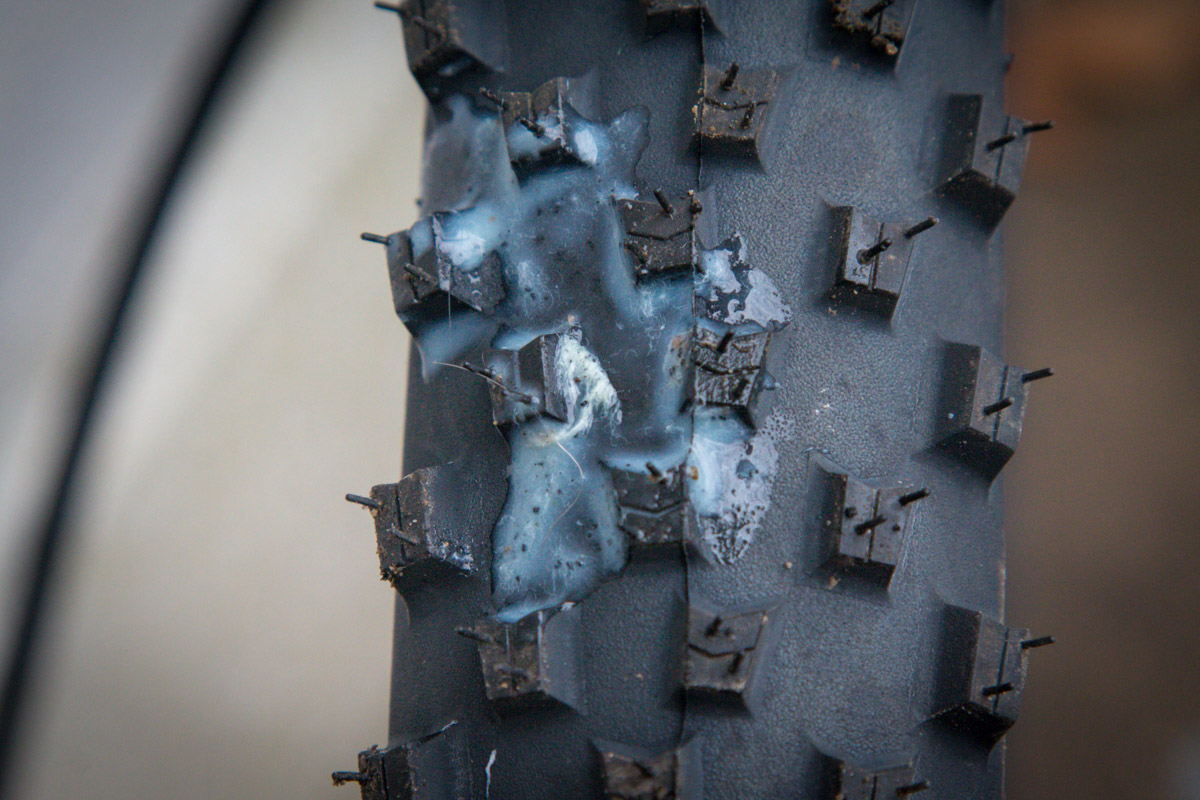There are a ton of tubeless sealants on the market, but most have one thing in common – leave them in your tire long enough, and they’ll dry up. When they do, you’ll be left with dried clumps or sticky patches of cured latex inside your tire. The new Finish Line Tubeless Tire Sealant promises to change that, along with delivering a new method of plugging leaks.
To be fair, there’s more than one company that played a part in the new sealant. Finish Line says that they partnered up with MULTI SEAL who are known for their tire sealants – just in industrial or military applications. Developing a sealant for a bicycle is quite different, so we’re told that this is an all new formula that the two co-developed.
Where the Finish Line Sealant differs is that it does not rely on liquid latex or ammonia. Finish Line claims that this makes the sealant non-toxic, hypoallergenic, safe for carbon fiber, and it even cleans up easily with water.
Without liquid latex, the sealant has to rely on another mechanism for sealing punctures which is where the Kevlar comes in. Called FiberLink technology, the sealant is filled with small pieces of DuPont Kevlar fibers which are forced into holes when there is a leak. When enough of those fibers are forced into the hole, they mesh up and create a plug. Since the liquid carrier isn’t tasked to be the sealant as well, Finish Line was able to use a liquid that won’t dry up over the life of the tire.
After some puncture testing of our own, the sealant works surprisingly well, plugging holes up to 1/4″ and cuts up to 1cm in the tread area, and it almost sealed a 1cm cut in the sidewall. As noted in the video, small amounts of air were still escaping from the plugged holes, but that could be due to the fact that we didn’t ride the tire after it was punctured. Finish Line states that as you ride, the FiberLink mesh will continue to tighten and reinforce the plug. That seems to match up with how the sealant plugged the larger holes above. Once it was sealed at lower pressure, adding more pressure would open up the hole a little more, and additional fibers would rush in and seal it again. You could keep going like that until the tire was holding pressure at 32psi. It’s pretty fascinating to see the strands of Kevlar sticking out of the holes after the sealant has plugged the leak.
When it comes to first impressions, the Finish Line sealant seems fairly impressive. If it lives up to the “it will never dry out, never need refreshing, and lasts the life of the tire” claims, then this is indeed a revolutionary tire sealant. Seeing as how we just got samples in last week, we’ll have to check back in with a long term review.
Finish Line recommends 2-3oz for road tires, 3-4oz for gravel, 3-4oz for 26/27.5″ tires, 4-5oz for 29″, and 6-8oz for fat bike tires. There’s no need to shake it, it’s safe to use with CO2 inflators, and it will work down to -10°f. Available soon, Finish Line will offer the sealant in 4oz, 8oz, 1 liter, and 1 gallon containers with prices TBA though expect it to be on par with current pricing of other tire sealants. For the shop setting, the big containers can be used with their industrial-grade pump which produces 1oz of sealant for each pump.
*Finish Line’s claim of a lifetime sealant has changed a bit since the product was launched. Under ideal conditions with a non-porous tire, the sealant performs as expected. But with more porous tires, the water portion of the sealant evaporates causing the sealant to thicken. Because of that, the company is no longer marketing the sealant as lifetime as of 09/2018.
For more details, check out our interview with Finish Line here.





